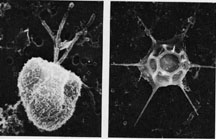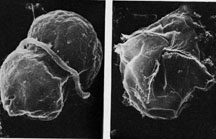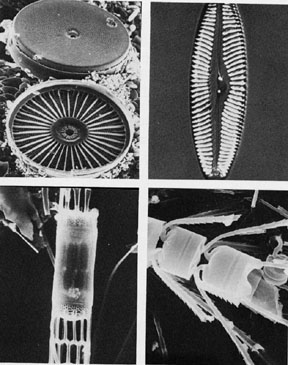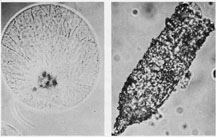
Adapted from Richard Strickland`s The Fertile Fjord; Plankton in Puget Sound Washington Sea Grant, University of Washington, 1983The biological configuration of the Puget Sound is inextricably tied to its physical and chemical configuration. Like both of these aspects of Puget Sound oceanography, the biological characteristics are highly variable in time and space. This section introduces organisms and concepts and processes defining the biological production of Puget Sound.
Plankton
Plankton are diminutive organisms, passively drifting or weakly swimming throughout Puget Sound. Though seemingly insignificant, these organisms are the foundation for a complex and very productive food web in Puget Sound. This section introduces you the cast of tiny characters that is the basic building block for all biological productivity in Puget Sound.
There are two major divisions of plankton: phytoplankton and zooplankton. Phytoplankton are primary producers, microscopic plants, which photosynthesize to produce their own food, which in turn provides nutrients for other organisms, or secondary consumers. Zooplankton are microscopic animal forms which graze upon phytoplankton and each other as they develop. Zooplankton provide food for other large aquatic organisms, like fish, mollusks and mammals, that subsequently feed birds, and other aquatic and terrestrial mammals.
In addition to generating food for an entire web of organisms, plankton provide other essential nutrients, notably oxygen. Strickland (1983, p. 3)
Phytoplankton today produces 95% of the oxygen generated in the sea, and at least one third of the earth`s oxygen... While most marine oxygen come form the expanses of the open oceans, areas such as the Puget Sound are more than ten times as productive for their area.
However, the decay of phytoplankton strips oxygen from water. Oxygen depletion is highly probable after a plankton bloom in portions of the Sound receiving relatively little circulatory activity.
Phytoplankton can only photosynthesize in the proper range of light intensity, temperature, nutrient and salinity conditions. The nutrients required by phytoplankton growth are nitrogen, phosphorous, carbon, potassium, sodium, calcium, and sulfur, all of which are common in some form in the sea. Also important are trace metals like, iron, manganese, cobalt, copper, nickel, tin and zinc. Nutrients are present in salt water in fairly constant ratios, which does not necessarily match the growth demands of phytoplankton given optimum growing conditions. In salt water, nitrogen is believed to be the limiting nutrient to plant growth. There are areas in which nutrient limitation is well documented, although these areas are in the minority. Examples are sheltered embayments, such as those in the South Sound in late summer. In most of Puget Sound, light availability seems to be the primary limiting factor for plankton production.
Phytoplankton
All phytoplankton cells have an outer cell membrane and inner cytoplasm. Some have an armored cell wall that is believed to have a variety of functions, such as inhibiting grazing by zooplankton. All reproduce asexually, by cell division, during which a parent cell divides itself into two offspring cells. Needless to say this sort of reproduction introduces an exponential growth curve while conditions are favorable. Phytoplankters can sexually reproduce as well in certain environmental conditions. In this process, a parent cell dissolves into sperms or eggs, which combine in the water column to produce zygotes.
The three primary categories of plankton in Puget Sound are determined by the physical characteristics related to their locomotion. Several very small unicellular organisms propel themselves with whip-like flagella. The photosynthetic varieties of these "flagellates" are termed phytoflagellates. Dinoflagellates include plant and animal forms that have two flagella and a unique cell structure. Diatoms have no flagella and relatively little locomotion. Examples of each category are pictured below (Strickland, 1983, p. 19).
These first images depict two varieties of phytoflagellates. On the left is a green flagellate, approximately 8 micrometers in actual size (most likely Pyramimonas). Note the flagella. To the right is the skeleton of Dichtyocha a golden-brown silicoflagellate, 50 micrometers in size. (Photos by Susan B. Stanton) This category is difficult to study because of its small size, and is proving to be much more abundant than previously believed.

The two images below depict two types of Dinoflagellates, to the left Gymnodinium and to the right, Gonyaulax. Gymnodinium is approximately 6 micrometers in size, and clearly illustrates a single flagellum running through the transverse groove. Gonyaulux, 30 micrometers in size, illustrates an armored shell, and is the cause of paralytic shellfish poisoning.( Photos by Beatrice C. Booth)

Pictured below are four varieties of diatom. The top left micrograph (National Marine Fisheries Service, NOAA, by Michael Eng) illustrates Coscinodiscus. The top right image depicts Navicula (School of Oceanography, UW). The bottom left image illustrates a chain of diatom Skeletonema (B. Dumbald). The bottom right photo depicts a Chaetoceros (Beatrice C. Booth).

Zooplankton
Like, phytoplankton, zooplankton can be divided into several categories. Zooplankton comprise many diverse groups of animals. Several phyla in marine environment have a planktonic phase as one or more developmental stages. Zooplankton are far more mobile than phytoplankton, and have far more sophisticated survival, foraging, and protection strategies. Sexual reproduction is the dominant form of reproduction for the zooplankton.
One category of zooplankton are the protozoans. These unicelluar organisms reproduce like phytoplankters, primarily by cell division or binary fission. They feed on very small phytoplankton and bacteria. Two illustrations (Strickland, 1983, p. 24) of protozoa are pictured below (Alexander J. Chester). The picture on the left shows Noctiluca, a dinoflagellate protozoan 100 micrometers in actual size. On the right is Tintinnopsis, a protozoan approximately 100 micrometers in length.

Another category of zooplankton are the crustaceans. By far the most common order of crustaceans are copepods. Copepods eat plant and animal food and their sizes and feeding structures are specifically adapted to their primary food source. Other members of larger shrimp-like planktonic crustaceans are the euphausiids, mysids, and hyperiid amphipods. These orders live in deeper waters than most copepods feeding on large phytoplankton, protozoa, copepods, fish larvae etc. Many of these organisms undertake a daily migration to deeper waters (100m) during daylight hours. Crustaceans rely upon sexual reproduction. Examples of an herbivorous copepod (upper left), carnivorous copepod (top right) and euphausiid " krill" (bottom) are pictured below ( Strickland, 1983, p. 24, Courtesy Mark D. Ohman).